| Habbaniya is a British field, but so
many American aircraft were landing there for servicing,
that when the control tower was built, half of the space
available in it was allotted to the Army Airways
Communications Service. I was a member of the Signal
Service team that installed the communication equipment
there. |
| We were a team. Here were the men who
comprised it. There was Gus Beck from Long Island. He was
the leader. He never commanded but only requested,
"Would you like to do this?" or, "Lets do
that." We liked him for it and tried to do as he
asked. He was a lean, lanky fellow and a mathematician
before he enlisted. |
John Maples came from Arkansas and had
been a farmer. He knew about building and structural
steel and welding and concrete. He was the oldest and was
short and heavy.
John Kurz had his home in Connecticut. He had sold
automobiles before the war and was full of wind and not
much else. He helped maples and did well enough at it.
Aaron Meyer came from Brooklyn. He had been a student,
but now he was and electrician. We called him Finnegan,
but I don't know why.
Fred Bryan came from Mississippi. We used to tease him
about white supremacy and lynchings and such. He was our
engine man and he could dismantle diesels with ease.
There was I, the radioman. I was green as grass on the
job and not afraid to tackle anything. I was proud and
eager to show what I knew. |
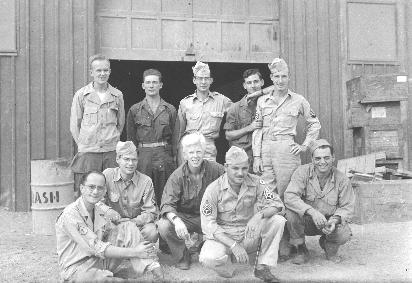 |
| We started in March 1945, and
completed it a few weeks after V-E Day. By that time we
had put into operation two VHF (very high frequency)
radio channels and on low frequency channel and a radio
range control panel. The VHF channels were capable of
communication with aircraft no more distant than 100
miles or about a half hour's flying time, but they had
the advantage or being nearly impervious to static and
other interference. The radio range was installed so that
a pilot attempting to find the field, during periods of
poor visibility (which often occur when high winds fill
the air with flying sand and dust) might be provided with
a radio pathway down which he might fly to find the
runway. |
| Thus the control tower operators have
at their command the means to communicate with all
aircraft in the vicinity and to direct them through safe
landings and take-offs. Provided, that is that the
visibility is of the order of a mile or so. |
| Our first task in equipping the
control tower at this desert field was to set up the
radio range transmitter and its associated antennas. We
decided to place it about 3 miles from the end of the
main runway to that the radio beam it generated would
flash straight down the runway to guide the homing pilot
safely to earth. Another beam we would beam we would aim
at Lydda Palestine, for that is the route to Cairo. A
third would lead to Abadan, where the oil of Iran flows
into the long low tankers of the Standard Oil and Texas
Companies. The fourth course of our range would point
toward Tehran and across the Caspian Sea into Russia.
From those places and to those places we would guide the
planes. |
| But we must first have a building to
house our transmitters with their multicolored indicator
lights, their dimly glowing tubes, their blue flashing
rectifiers, their clicking relays, and humming fans and
keying meters. There must be shelter too for the
diesel-electric generators. Many Kilowatts of electricity
are needed to generate the strong unfaltering beams that
we intended to have, and there are no handy power lines
out there. |
| So we set about to build us a building
in the desert where the only living things are big black
beetles and the foot long yellow lizards that pray upon
them. |
| We had plenty of bricks and mortar,
and Arabs to help. We had an Indian surveyor, and
Armenian foreman and an English contractor. When finally
they were done we had a building of sorts. The roof was
not waterproof. The floor was not smooth and flat. The
foundation was not level. The wind and the sand
penetrated the walls unhindered, for the mortar had dried
before hardening and was now falling out. The windows
would not open and the doors could not be kept shut. The
lumber had been green, so it shrank in the dryness and
the glue would not stick. We had a mess of a building and
I could have kicked it down with my bare feet, but we
called it a building and went to work. |
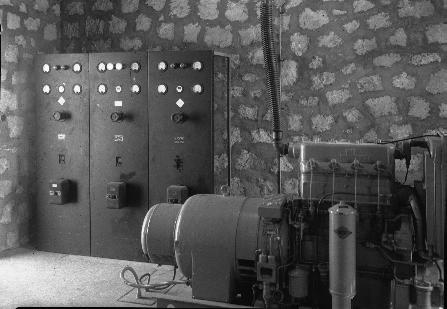 |
| In went the transmitters, two of them,
at on ton apiece and were bolted down. In went the
engines and generators. Twice that each weighed and there
were three of them. Then there were wires and switches
and transformers to connect. Tubes came out of their
excelsior packed cartons and were twisted into their
sockets. I hunted high and low for the little cloth bag
of dots and dashes that I knew must be there. We needed
them to fasten to a slowly rotating wheel; they make our
transmitter send, hour on hour, day after day for months
on end, automatically in Morse, its call letters
"HN". "Dit dit dit dit dah dit," it
would go, and all who listened would know that this was
the way to Habbaniya. "Follow me," it would say
in its cryptic tongue, "and I will lead you to
Lydda, to Cairo, to Tehran, to Russia, to Abadan, to
Karachi, to China and beyond, where my brothers will lead
you still further, unafraid, in sure straight lines, over
oceans and seas, over cruel mountain peaks and over
strange countries." On and On we will guide you till
you may circle the globe and return again from the
west." I had to have those dots and that one dash.
But there were none. I asked the others, " Have you
seen a little white cloth bag of dots and dashes?"
They, wise ones, laughed, thinking I joked, for a dot is
not found in a bag. It is something you make tapping your
fingers on a telegraph key. I searched no more but sent a
message to Cairo for spares. The answer was short but
complete. "Improvise." it said. "Bakelite
and file." Said the Lieutenant. For three days I
filed and fitted. My fingers were sore and the Bakelite
was gone, but I had them, the Morse letters
"HN". They'd know our station when they heard
it. |
| Next came the antennas. Four of them
there were, arranged in a square 300 feet on a side with
our building in the centre. They were thin steel lattice
works projecting one hundred feet into the clear air or
the Syrian Desert. Each was kept from falling by three
strong steel cables and each was topped by a bright red
light to warn away low flying planes. We wanted no
repetition of the affair at Cairo where a B-29 had
clipped off thirty feet of a steel antenna like ours. The
steel we erected by a peculiar method. It went up in
sections. First the top section guyed by strong ropes,
was lifted into the air by crane and the next lower
section bolted to it from the bottom. Then both were
lifted again and the third section was attached at their
lower end, and so on. Thus our antennas were literally
put up from the top down. |
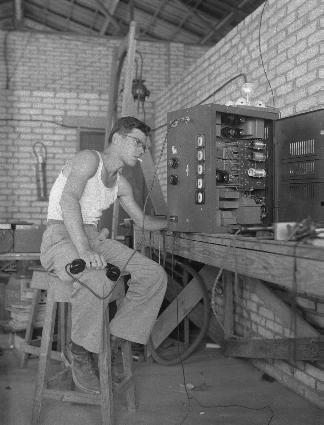
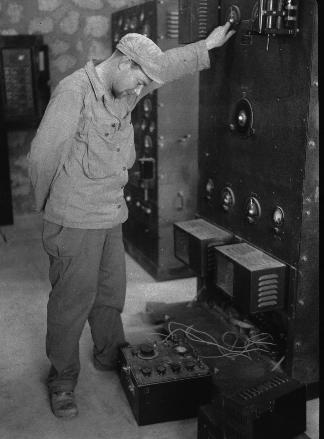 |
| The hard work was at length done, and
the riggers lay in the sun or swam in the lake while our
Arabs dug trenches and buried the cables that would feed
electricity to the Obstruction lights and powerful radio
waves to the four antennas. |
| Our station was finished. All that
remained was to adjust the shiny chromium dials and watch
the emotionless needles of the meters as they told their
story of what was happening in the orderly maze of wires,
coils, and electron tubes that lay behind the dull black
panels. That would be my job alone, I thought. I was
proud that I knew how to manipulate those dials so that
our range would lay its courses straight and true and
unwavering. The evening plane from Cairo brought us a new
team member. He smoked a huge cigar and was called
"Stogie" Worral. "The best ranger tuner
upper in the whole Middle East," the Lieutenant
said. I was to be an errand boy, it seemed, on this, the
most critical part of the job. Should I refuse to admit
that I was resentful? He was good, darn good, and soon I
found myself admiring his swift, sure knowledge. It was
not long till I had to admit to myself that I liked him.
How can you dislike a man who agrees with you while
making sure you do the right thing and saves you from the
time wasting errors? I couldn't. |
| Our range was done. The pilots had
checked it and said that it was reliable. The aerial
highway it laid out was marked on their maps. We could
leave our jerrybuilt shack and go elsewhere. The
maintenance men would keep the engines going and sweep
the dust away from the door. We could turn our backs on
it. |
| We went back to work in the tower.
They wanted the VHF circuits in first. Sweating, grunting
Arab laborers dragged the small but heavy transmitter up
the narrow stairs of the tower. The antenna went up
quickly, the tubes went into their sockets, and we were
on the air. It worked from the start and gave us no
trouble. |
| One day while we worked in the tower a
British Mosquito bomber come into land. The pilot said,
"Landing instructions please." The tower
operator said, "The wind is north, fourteen miles
per hour. The altimeter setting is 29.75. Land on runway
34. Call again on your downwind leg." The pilot
said, "That is fine but my wheels wont come
down." The engineering officer was called and said,
"Add more Hydraulic Fluid." After the pilot had
carried out this advice the tail wheel still remained
hidden, nor was there any more fluid aboard. There was 15
minutes of gas in the tanks, though, and the pilot
becoming uneasy was able to solve this problem in a
natural way. He landed safely and had nothing whatever to
say concerning the matter. |
| We worked on that tower with vim and
vigor and soon had installed and array of speakers and
microphones, receivers and switches. The top of the tower
bristled with antennas. They were vertical whips of
various lengths. Each was attached to its particular
receiver and each was attuned like a sensitive feeler to
some distant station that we wanted to hear. |
| Iraqi pilots were trained in
Habbaniva. They spoke no English and we spoke no Arabic.
This situation seemed certain to lead to complications,
and did in short order. Two planes cannot use the same
runway simultaneously, especially if on pilot is unaware
of the other and not particularly interested in using his
radio because he dislikes being told what to do in a
language he doesn't understand. I have seen good brown
English hair turn white while an operator was trying to
prevent an Iraqi training plane from taking off in the
path of an incoming British transport. |
| French planes occasionally landed
there. It was startling to see a French operated, German
Junkers Ju-52 come floating in without warning or a
by-your-leave. |
| There were Russians who would loop a
transport or make a take-off without with out first
warming or checking the engines. Damn fools they were,
perhaps, but I never saw one crash. There was the plane
loaded with passengers that found refuge from a dust
storm by following the beam of our range down to its
origin and landed safely at our field. |
| There was a thunderbolt fighter that
failed to reach the field and crashed on a ridge 2 miles
away. They buried the pilot that night. There was a B-25
pilot who landed his plane tail down and nearly tore off
the stern of his airplane. |
| During the few short month I worked in
the brick and glass tower and on the nearby desert there
were many occurrences to laugh about and others that
brought tears to some. A few of them I shall never
forget. Many I have already forgotten, and others I wish
I could not remember. |
| It is not likely that any of the work
we did there helped in any way to shorten the conflict,
but at least we had the satisfaction of knowing that we
did a good job with the materials and tools at hand. |
| I can recall no three months, which
were more pleasantly occupied than those I spent in a
modern "Tower of Babel." |
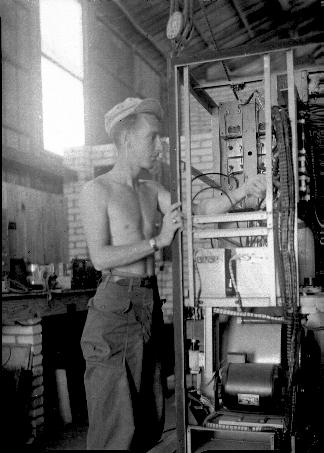 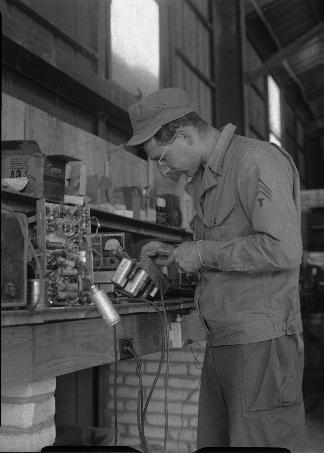 |
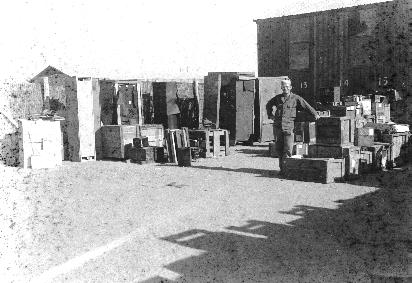 |